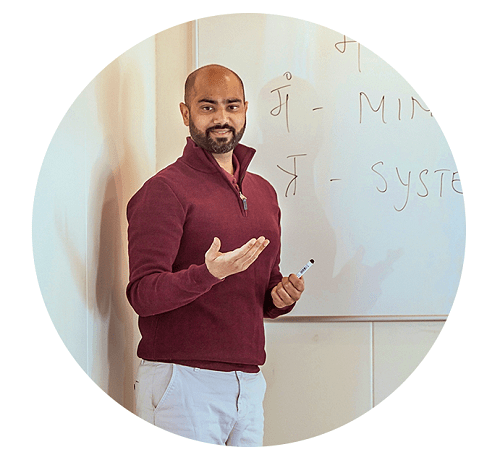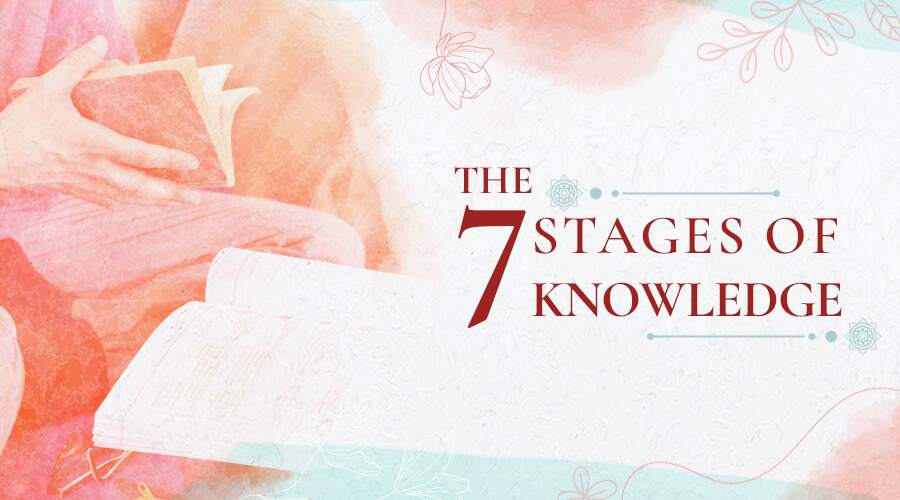The Seven Stages of Knowledge
The Seven Stages of Knowledge are considered one of the main concepts of yoga philosophy. Nowadays yoga is known for it’s physical health benefits. Often when we talk about yoga, what we refer to is solely the physical practice of yoga asanas. And when thinking about the underlying philosophy, one of the first concepts that comes to mind are the energy body and the 7 Chakras. However, the ancient philosophy behind these popular concepts of yoga have so much more to offer. Essentially the practice of yoga is a holistic science, surpassing mere physical exercises and including our entire life and lifestyle. If one chooses so, yoga is a complex and well-defined spiritual path with the goal of self-growth and eventually self-realization.
Whereas the Eight Limbs of Raja Yoga describe the actions to take in order to reach the ultimate goal of yoga, the Seven Stages of Knowledge describe the inner development that a spiritual practitioner goes through. The Seven Stages of Knowledge are described in the Yoga Vashistha, an ancient dialogue between Maharishi Vashishta and his disciple Lord Ram. It gives the identification of different stages of knowledge in the spiritual path of a sadhaka (a spiritual seeker). Every Yogi goes through these stages of development before achieving complete liberation. The path of knowledge starts at the low level of awareness (also known as Subbecha) towards Samadhi, the highest level of knowledge. But how can you know where you are is on this path? The Vedas have explained the Seven Stages of Knowledge in a comprehensive way, in order to give the spiritual seeker a tool to measure his or her progress.
Stage 1. SUBBECHA – The Longing for the Truth
There are four pre-stages of Subbecha, and the stage can only be completed after all pre-stages are achieved.
(A) Viveka: The power of discrimination
This level of awareness is achieved when the spiritual seeker is completely aware of the difference between real and unreal, permanent and impermanent.
What is unreal?
When the form or matter of a thing can change it is consider to be unreal. So all material things are unreal as their form or shape can be changed. For example a tree can be cut and converted into a table or chair.
What is real?
When the form or matter of a thing cannot change it is consider to be real. As per the Vedas only the soul is permanent and therefore real. For example when a human being dies its only the body which goes back in to 5 elements but the soul continues to take a new body.
(B) Vairagya: Dispassion for the unreal
Once the seeker achieves viveka his interest in temporary things diminishes and slowly fades away. There is no attachment to belongings or people. Example when a family member dies, a person may get sad about it but is still aware of the circle of life and death.
(C) Shatsampat: Mastery of the six senses
When the seeker masters his six senses (hear, touch, see, taste, smell and intuition) he reaches the level of Shatsampat. The five senses help us to get information to the brain and the intuition is the information we get without using any of the five senses. We are supposed to use these senses only for knowing and input, but we, due to lower natures, began to indulge in these senses. When we master our senses we don’t react anymore to the senses we experience. For example if we smell garbage but we don’t have any reaction with this information, we don’t like it and we don’t dislike it.
(D) Mumukshutava: Deep desire for liberation
In this level we cherish the deep desire for the place where you go after liberation, that place is MOKSHA. Liberation is also called Nirvana. At this level, the seeker understands the misery of the life forms and thus wants to get liberated from the circle of life and death.
After reaching the stage of Mumukshatava, the Sadhaka has now developed Subbecha.
Stage 2. VICHARANA- The Right Inquiry
In this stage the seeker wants to find the right information and the right teaching. He wants to get to Moksha and thinks about How to get there all the time. He reflects on his past life, his current life, and the lives of those who have attained Moksha and tries to find the answers.
Stage 3. TANUMANASANA – Bringing the Focus to the One
Once the seeker finds out the way to get to Moksha he is strongly focused on the path of getting to the Moksha. There are no other thoughts left and he is only focused on How to reach his goal and the goal itself.

Discover yoga philosophy principles to boost your happiness
Get free access to a life-changing series of 6 webinars with Arhanta Yoga founder Ram Jain
Stage 4. SATTVAPATI – The Attainment of Purity
At this level the seeker becomes Sattvic while following the divine path towards Moksha. After diligently following his path, the sadhaka becomes pure. In this stage the sadhaka sometimes acquires siddhis (astral powers), if he stays unaffected by these powers then he will be able to enter the fifth stage.
Stage 5. ASAMSHAKTI – The Ultimate Victory
In this stage the person becomes unaffected by anything and he has mastered his ego. There are no longer senses uncontrolled for example eating or drinking or using hot water just for satisfaction. The seeker is pure and may receive astral powers, like walking on water or healing. There is no ego left and if it does turn up the person falls back to level Zero.
Stage 6. PADARTHBHAWNA – Seeing the Truth Beyond Maya
In this stage the seeker sees the reality behind everything. He sees a tree instead of a chair, he sees an animal instead of a leather boot. He is aware of the fact that a dead body is just the outside part of a human being, the soul is the real self. This person sees the truth beyond the illusion.
Stage 7. TURIYA – The Separation
This is the stage of perpetual Samadhi, in this stage the karma is finished and the seeker is almost ready to be liberated (to be released from the perpetual circle of life and death).
Mastering the Seven Stages of Knowledge is not something a spiritual aspirant can accomplish in a week. It is a process that can take years (even decades) and that requires a lot of patience, willpower and devotion. Do you want to read more about the ancient Yoga Philosophy: The Four Vedas or The Principles of Karma. (These philosophical discourses are part of the curriculum of our 200 hour yoga teacher training courses)

